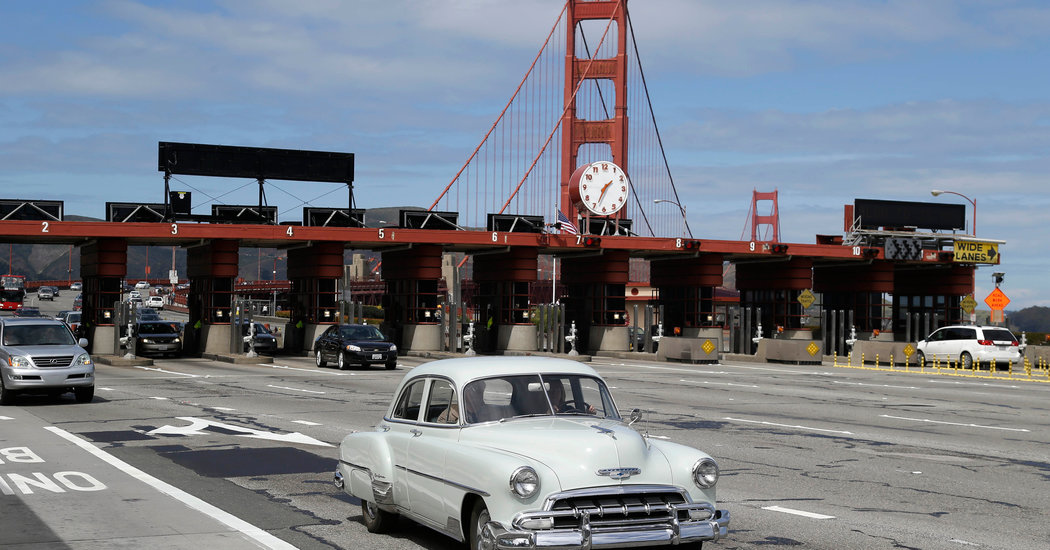
No one wants hassles on vacation, so this fall my wife and I accepted the offer of a rental car agent in San Francisco who suggested there was a fast, easy way to pay any tolls we might encounter.
We were in California to see friends on a trip that took us north into Sonoma County and then down the sumptuous Pacific Coast Highway to San Diego.
A lot of driving and, we thought, a lot of tolls. So the deal, $80.43 to use a PlatePass electronic toll transponder for seven days ($11.49 a day), seemed decent. (After all, as New Yorkers, we know one can spend $16, and much too much of your life, just to struggle across the George Washington Bridge once.)
But, as it turned out, over the course of our 600-mile trip — up to the wine country, back down to San Francisco, through Pacifica and Carmel and Big Sur and Santa Barbara to San Diego — we encountered exactly one toll, at the Golden Gate Bridge. It cost $8.20 — roughly 10 percent of what we had paid for the pass.
I felt silly, but discovered I’m in good and sizable company. Despite years of regulatory actions, class-action suits and fee rollbacks by companies, there is still confusion over the way some rental car companies deal with electronic tolls.
As cashless tolls become more prevalent, drivers without transponders — those windshield-mounted devices that many call E-Z Passes — can find themselves on roads where they have no immediate option to pay. Instead they often receive a mailing based on an image of their plate taken at the toll. In the case of rental cars, the notification goes to the company.
If you don’t sign up for an electronic toll pass, some companies tack on an administrative fee — as much as $15 — for each cashless toll encountered. And if you do, some companies charge a daily fee of $12 or more for the pass, even on the days when you never hit a toll.
The latter happened to Robert Bauman, a retired teacher from Michigan, during a family trip to Texas in November. His toll bill from tolls: $9.96. His bill from Advantage Rent a Car: $102.37. The difference: $92.41, or the $12.99 daily pass fee for six days plus taxes and fees.
Advantage pointed out that its fee was fully disclosed on the rental agreement he signed. Mr. Bauman argued that he didn’t notice it among the fine print and that it went otherwise unmentioned.
“There’s no way we would have ever paid a fee like that,” he said.
Adequate disclosure has been the crux of the issue as it has played out in litigation and regulatory actions. And travelers at the head of a line, at a rental desk, on a timetable, can be harried, vulnerable, undiscriminating consumers.
“Often they are not in their home jurisdictions,” said Bruce Greenberg, a lawyer who has represented drivers in two class action suits, “so they are not familiar with how tolling works there.”
The companies say the fees cover things like the cost of maintaining fleets of transponders and coordinating payments with local authorities. Greg Scott, a spokesman for the American Rental Car Association, said its members find “themselves in a challenging position: making sure tolling authorities — who use different transponders, payment and accounting systems — receive the payments they are expecting, while also making sure rental car customers receive disclosure and transparency about those tolls and fines.”
The Dollar Thrifty Automotive Group has prevailed in two suits where judges agreed the fees were appropriately outlined in rental agreements that drivers signed. But last year the company settled a lawsuit brought by the Florida Attorney General by agreeing to put $330,000 toward possible refunds and pledging to provide adequate disclosure about fees and about how drivers can avoid the charges.
Hertz agreed last year to pay $3.65 million to San Francisco to settle a 2017 lawsuit in which the city accused it of deceiving customers about the fees they could face for crossing the Golden Gate Bridge. Hertz acknowledged no wrongdoing. It revised its toll policy nationwide in 2018 and now charges a $5.95 daily fee for use of a transponder, but only on the days when tolls are actually encountered.
Though that policy addressed the criticism, Charles Leocha, the president of Travelers United, an advocacy group, pointed out that Thrifty, which is owned by Hertz, still typically charges higher daily fees for every day of a rental, regardless of whether a toll is encountered. “They are just seeing how far they can go with the different standards,” he said.
Hertz responded in a statement: “Our brands have different business models, service options and pricing to serve a range of customers and their unique needs.”
Some things to think about to avoid problems:
Try to learn the company policy before you hit the counter. Remember toll fees are only part of the price. If a company offers a cheaper rental rate, it may be worth paying more for toll fees.
Can you use your own transponder? Maybe. Check with your provider to see if you can bring it from home and use it in a rental car.
Plan your itinerary. If I’d done my homework, I would have seen that I’d only encounter one toll on my trip. I should have skipped the PlatePass and just paid an administrative fee of $15 for the one Golden Gate Bridge toll. (And I could have avoided any fee by paying the bridge fee online within two days of crossing.)
Complain. That’s what Mr. Bauman did, patiently and nicely, over a period of weeks. Advantage did not acknowledge any error, but as a sign of good faith reimbursed him for everything but his $9.96 toll bill.
“Being an elementary schoolteacher,” he said, “I know from teaching the kids, the world works better when you’re respectful.”






